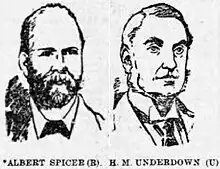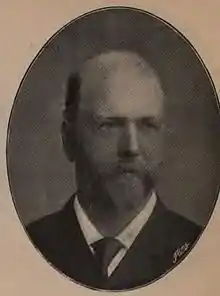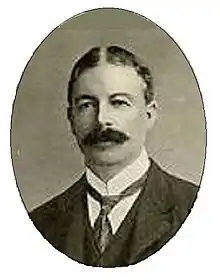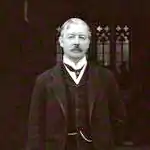Monmouth Boroughs (UK Parliament constituency)
Monmouth Boroughs (also known as the Monmouth District of Boroughs) was a parliamentary constituency consisting of several towns in Monmouthshire. It returned one Member of Parliament (MP) to the House of Commons of the Parliaments of England, Great Britain, and finally the United Kingdom; until 1832 the constituency was known simply as Monmouth, though it included other "contributory boroughs".
| Monmouth Boroughs | |
|---|---|
| Former Borough constituency for the House of Commons | |
| 1545–1918 | |
| Seats | one |
| Replaced by | Monmouth and Newport |
History and boundaries
The area was first enfranchised as the single-member borough of Monmouth or Monmouth Town in the reign of Henry VIII, at the same time as the counties and boroughs of Wales. On official, national-level paper cast as being in England its electoral arrangements from the outset resembled those of the Welsh boroughs rather than those in the rest of England - its single member and its other "contributory boroughs" in the same county, which were required to contribute to the members' expenses and which had the right to send voters to take part in the election at the county town. These were initially six or perhaps seven in number: Caerleon, Newport, Trellech, Usk, Chepstow, Abergavenny and possibly Grosmont; but by the late 17th century all of the electors were freemen of Monmouth, Usk and Newport.
The franchise was settled by a judgment in a disputed election in 1680, when Monmouth attempted to return a member to parliament without the involvement of the other boroughs, and the Court declared the right to vote to rest in the resident freemen of Monmouth, Newport and Usk. The number of electors fell away sharply during the 18th century - from 2,000 in 1715 to about 800 in the 1754-1790 period; by the time of the Great Reform Act in 1832 qualified voters numbered: 123 in Newport, 83 in Monmouth and 74 in Usk. In Tudor times the seat was under the influence of the Duchy of Lancaster and around the start of the 18th century it was a pocket borough of the Morgan family of Tredegar, who were influential in the Newport area; but soon afterwards the Dukes of Beaufort (a Scudamore family branch) gained control. After the Duke's candidate had won the election of 1715 decisively, this patronage was so clear contests ceased until 1820 – their candidates (many of them members of the family) were returned unopposed.
At the time of the Great Reform Act (or First Reform Act), 1832, Monmouth and Newport each had around 5,000 residents and Usk just over 1,000. This was great for most seats of its type – even dual-member boroughs were mostly kept if they had or could be simply drawn to exceed 4,000 residents. Nevertheless, all three parts of this seat were expanding by taking into the new high-rent-paying and/or landed outlook (franchise) a broad view of each town; such area took in 13,101 people and its electorate (under the "reformed" franchise) was 899. Henceforth it was generally referred to as the Monmouth Boroughs.

From 1832 until 1906 results tended on 'marginal' rather than 'safe', alternating between Conservatives and Whigs/Liberals. Crawshay Bailey (Con.) was returned unopposed four times after he was first elected. The seat moved steadily towards the Liberals, however, as the franchise became more inclusive and Newport grew in size; by the turn of the century 90% of the electorate was there, and it was a mass-labour working class and mainly industrial town unlike Monmouth and Usk. The Conservatives won in their landslide year of 1900 and held the seat in the by-election when that election was voided for various irregularities, but were probably helped by the association of the Liberal candidate with the campaign to extend the Welsh Sunday Closing Act to Monmouthshire. After, it was identifiably "safely" Liberal, and at the time of the 1911 census had a population of 77,902.
The seat was abolished by the Representation of the People Act 1918: Newport became a parliamentary borough; Monmouth and Usk, mainstays of "Monmouth" county constituency.
Boundary reforms
Redefined limits of the three contributory boroughs were set in 1832 and 1885.
Members of Parliament
1545-1640
| Parliament | First member |
|---|---|
| 1542 | Thomas Kynnyllyn[1] |
| 1545 | Richard Morgan, also elected for Gloucester[1] |
| 1547 | Giles Morgan[1] |
| 1553 (Mar) | (not known)[1] |
| 1553 (Oct) | John Philip Morgan[1] |
| 1554 (Apr) | John Philip Morgan[1] |
| 1554 (Nov) | John Philip Morgan[1] |
| 1555 | Thomas Lewis[1] |
| 1558 | Matthew Herbert[1] |
| 1559 | Moore Powell[2] |
| 1562 | Moore Powell[2] |
| 1571 | Charles Herbert[2] |
| 1572 | Moore Powell, died and replaced 1576 by Sir William Morgan[2] |
| 1584 | Moore Gwillim[2] |
| 1586 | Moore Gwillim[2] |
| 1588 | Philip Jones[2] |
| 1593 | Edward Hubberd[2] |
| 1597 | Robert Johnson[2] |
| 1601 | Robert Johnson[2] |
| 1604-1611 | (Sir) Robert Johnson |
| 1614 | Sir Robert Johnson |
| 1621-1622 | Thomas Ravenscroft |
| 1624 | Walter Stewart or Steward |
| 1625 | Walter Stewart or Steward |
| 1626 | William Fortune |
| 1628 | William Morgan |
| 1629–1640 | No Parliaments summoned |
1640-1918
Election results
Elections in the 1830s
| Party | Candidate | Votes | % | ||
|---|---|---|---|---|---|
| Tory | Henry Somerset | Unopposed | |||
| Tory hold | |||||
| Party | Candidate | Votes | % | ||
|---|---|---|---|---|---|
| Whig | Benjamin Hall | 168 | 53.0 | ||
| Tory | Henry Somerset | 149 | 47.0 | ||
| Majority | 19 | 6.0 | |||
| Turnout | 317 | ||||
| Whig gain from Tory | |||||
- On petition, Hall was unseated and Somerset was declared elected.
| Party | Candidate | Votes | % | ±% | |
|---|---|---|---|---|---|
| Whig | Benjamin Hall | 393 | 52.5 | −0.5 | |
| Tory | Henry Somerset | 355 | 47.5 | +0.5 | |
| Majority | 38 | 5.0 | −1.0 | ||
| Turnout | 748 | 83.2 | |||
| Registered electors | 899 | ||||
| Whig hold | Swing | −0.5 | |||
| Party | Candidate | Votes | % | ±% | |
|---|---|---|---|---|---|
| Whig | Benjamin Hall | 428 | 50.2 | −2.3 | |
| Conservative | Joseph Bailey | 424 | 49.8 | +2.3 | |
| Majority | 4 | 0.4 | −4.6 | ||
| Turnout | 852 | 78.3 | −4.9 | ||
| Registered electors | 1,088 | ||||
| Whig hold | Swing | −2.3 | |||
| Party | Candidate | Votes | % | ±% | |
|---|---|---|---|---|---|
| Whig | Reginald Blewitt | 440 | 53.3 | +3.1 | |
| Conservative | Joseph Bailey | 386 | 46.7 | −3.1 | |
| Majority | 54 | 6.6 | +6.2 | ||
| Turnout | 826 | 70.7 | −7.6 | ||
| Registered electors | 1,169 | ||||
| Whig hold | Swing | +3.1 | |||
Elections in the 1840s
| Party | Candidate | Votes | % | ±% | |
|---|---|---|---|---|---|
| Whig | Reginald Blewitt | 476 | 100.0 | +46.7 | |
| Chartist | William Edwards[9] | 0 | 0.0 | New | |
| Majority | 476 | 100.0 | +93.4 | ||
| Turnout | 476 | 37.5 | −33.2 | ||
| Registered electors | 1,268 | ||||
| Whig hold | Swing | +46.7 | |||
| Party | Candidate | Votes | % | ±% | |
|---|---|---|---|---|---|
| Whig | Reginald Blewitt | Unopposed | |||
| Registered electors | 1,420 | ||||
| Whig hold | |||||
Elections in the 1850s
Blewitt resigned by accepting the office of Steward of the Manor of Hempholme, causing a by-election.
| Party | Candidate | Votes | % | ±% | |
|---|---|---|---|---|---|
| Conservative | Crawshay Bailey | 764 | 59.1 | New | |
| Whig | William Schaw Lindsay[10][11] | 529 | 40.9 | N/A | |
| Majority | 235 | 18.2 | N/A | ||
| Turnout | 1,293 | 77.1 | N/A | ||
| Registered electors | 1,676 | ||||
| Conservative gain from Whig | Swing | N/A | |||
| Party | Candidate | Votes | % | ±% | |
|---|---|---|---|---|---|
| Conservative | Crawshay Bailey | Unopposed | |||
| Registered electors | 1,676 | ||||
| Conservative gain from Whig | |||||
| Party | Candidate | Votes | % | ±% | |
|---|---|---|---|---|---|
| Conservative | Crawshay Bailey | Unopposed | |||
| Registered electors | 1,744 | ||||
| Conservative hold | |||||
| Party | Candidate | Votes | % | ±% | |
|---|---|---|---|---|---|
| Conservative | Crawshay Bailey | Unopposed | |||
| Registered electors | 1,745 | ||||
| Conservative hold | |||||
Elections in the 1860s
| Party | Candidate | Votes | % | ±% | |
|---|---|---|---|---|---|
| Conservative | Crawshay Bailey | Unopposed | |||
| Registered electors | 2,087 | ||||
| Conservative hold | |||||
| Party | Candidate | Votes | % | ±% | |
|---|---|---|---|---|---|
| Liberal | John William Ramsden | 1,618 | 52.8 | New | |
| Conservative | Samuel Homfray[12] | 1,449 | 47.2 | N/A | |
| Majority | 169 | 5.6 | N/A | ||
| Turnout | 3,067 | 81.3 | N/A | ||
| Registered electors | 3,771 | ||||
| Liberal gain from Conservative | Swing | N/A | |||
Elections in the 1870s
| Party | Candidate | Votes | % | ±% | |
|---|---|---|---|---|---|
| Conservative | Thomas Cordes | 2,090 | 59.1 | +11.9 | |
| Liberal | Henry Pochin[13] | 1,447 | 40.9 | −11.9 | |
| Majority | 643 | 18.2 | N/A | ||
| Turnout | 3,537 | 75.2 | −6.1 | ||
| Registered electors | 4,702 | ||||
| Conservative gain from Liberal | Swing | +11.9 | |||
Elections in the 1880s
| Party | Candidate | Votes | % | ±% | |
|---|---|---|---|---|---|
| Liberal | Edward Carbutt | 2,258 | 50.7 | +9.8 | |
| Conservative | Thomas Cordes | 2,197 | 49.3 | −9.8 | |
| Majority | 61 | 1.4 | N/A | ||
| Turnout | 4,455 | 87.5 | +12.3 | ||
| Registered electors | 5,090 | ||||
| Liberal gain from Conservative | Swing | +9.8 | |||
.jpg.webp)
| Party | Candidate | Votes | % | ±% | |
|---|---|---|---|---|---|
| Liberal | Edward Carbutt | 2,932 | 50.1 | −0.6 | |
| Conservative | Thomas Cordes | 2,921 | 49.9 | +0.6 | |
| Majority | 11 | 0.2 | −1.2 | ||
| Turnout | 5,853 | 90.3 | +2.8 | ||
| Registered electors | 6,485 | ||||
| Liberal hold | Swing | −0.6 | |||
| Party | Candidate | Votes | % | ±% | |
|---|---|---|---|---|---|
| Conservative | George Elliot | 3,033 | 54.2 | +4.3 | |
| Liberal | Edward Carbutt | 2,568 | 45.8 | -4.3 | |
| Majority | 465 | 8.4 | N/A | ||
| Turnout | 5,601 | 86.4 | -3.9 | ||
| Registered electors | 6,485 | ||||
| Conservative gain from Liberal | Swing | +4.3 | |||
Elections in the 1890s
| Party | Candidate | Votes | % | ±% | |
|---|---|---|---|---|---|
| Liberal | Albert Spicer | 3,430 | 52.2 | +6.4 | |
| Conservative | George Elliot | 3,137 | 47.8 | −6.4 | |
| Majority | 293 | 4.4 | N/A | ||
| Turnout | 6,567 | 85.3 | −1.1 | ||
| Registered electors | 7,697 | ||||
| Liberal gain from Conservative | Swing | +6.4 | |||

| Party | Candidate | Votes | % | ±% | |
|---|---|---|---|---|---|
| Liberal | Albert Spicer | 3,743 | 51.1 | −1.1 | |
| Conservative | Emanuel Maguire Underdown | 3,589 | 48.9 | +1.1 | |
| Majority | 154 | 2.2 | −2.2 | ||
| Turnout | 7,332 | 87.4 | +2.1 | ||
| Registered electors | 8,391 | ||||
| Liberal hold | Swing | −1.1 | |||
Elections in the 1900s

| Party | Candidate | Votes | % | ±% | |
|---|---|---|---|---|---|
| Conservative | Frederick Rutherfoord Harris | 4,415 | 54.2 | +5.3 | |
| Liberal | Albert Spicer | 3,727 | 45.8 | −5.3 | |
| Majority | 688 | 8.4 | N/A | ||
| Turnout | 8,142 | 87.2 | −0.2 | ||
| Registered electors | 9,335 | ||||
| Conservative gain from Liberal | Swing | +5.3 | |||

| Party | Candidate | Votes | % | ±% | |
|---|---|---|---|---|---|
| Conservative | Joseph Lawrence | 4,604 | 51.9 | −2.3 | |
| Liberal | Albert Spicer | 4,261 | 48.1 | +2.3 | |
| Majority | 343 | 3.8 | −4.6 | ||
| Turnout | 8,865 | 90.4 | +3.2 | ||
| Registered electors | 9,803 | ||||
| Conservative hold | Swing | −2.3 | |||

| Party | Candidate | Votes | % | ±% | |
|---|---|---|---|---|---|
| Liberal | Lewis Haslam | 4,531 | 44.7 | −1.1 | |
| Conservative | Edward Emanuel Micholls | 3,939 | 38.8 | −15.4 | |
| Labour Repr. Cmte. | James Whinstone | 1,678 | 16.5 | New | |
| Majority | 592 | 5.9 | N/A | ||
| Turnout | 10,148 | 90.6 | +3.4 | ||
| Registered electors | 11,207 | ||||
| Liberal gain from Conservative | Swing | +7.2 | |||
Elections in the 1910s
| Party | Candidate | Votes | % | ±% | |
|---|---|---|---|---|---|
| Liberal | Lewis Haslam | 6,496 | 54.8 | +10.1 | |
| Conservative | Charles Cayzer | 5,351 | 45.2 | +6.4 | |
| Majority | 1,145 | 9.6 | +3.7 | ||
| Turnout | 11,847 | 91.6 | +1.0 | ||
| Registered electors | 12,934 | ||||
| Liberal hold | Swing | +1.9 | |||

| Party | Candidate | Votes | % | ±% | |
|---|---|---|---|---|---|
| Liberal | Lewis Haslam | 6,154 | 54.9 | +0.1 | |
| Conservative | Gerald de La Pryme Hargreaves | 5,056 | 45.1 | -0.1 | |
| Majority | 1,098 | 9.8 | +0.2 | ||
| Turnout | 11,210 | 86.7 | −4.9 | ||
| Registered electors | 12,934 | ||||
| Liberal hold | Swing | +0.1 | |||
General Election 1914–15:
Another General Election was required to take place before the end of 1915. The political parties had been making preparations for an election to take place and by the July 1914, the following candidates had been selected;
- Liberal: Lewis Haslam
- Unionist:
Notes and references
Notes
- Jones was also elected for Beaumaris, but had not chosen his seat before parliament was dissolved
- The election of November 1640 was disputed between William Watkins and Thomas Trevor. Watkins took his seat at the very beginning of the Parliament, but was then instructed to cease attending until the dispute had been resolved; in fact this had not happened by the time of the outbreak of the Civil War, and proceedings were then put in abeyance and neither ever gained the seat. Watkins was disabled from sitting for his adherence to the Royalist cause while Trevor was elected for another constituency, and a writ to fill the vacant seat was eventually issued in 1646.
- On petition, Herbert was declared not to have been duly elected, having been returned only by the freemen of Monmouth, and his opponent Arnold (who had the majority once the votes of Newport and Usk were included) was declared elected in his place
- Succeeded to a baronetcy, October 1772
- Worcester was re-elected in 1790, but had also been elected for Bristol, which he chose to represent, and did not sit again for Monmouth
- Created a baronet, 1797
- On petition, Hall's election was overturned and the Marquess of Worcester declared re-elected in his place
- On petition, the election of Harris was declared void and a by-election held
References
- "History of Parliament". History of Parliament Trust. Retrieved 2 June 2013.
- "History of Parliament". History of Parliament Trust. Retrieved 16 October 2011.
- Stooks Smith, Henry. (1973) [1844-1850]. Craig, F. W. S. (ed.). The Parliaments of England (2nd ed.). Chichester: Parliamentary Research Services. pp. 219–220. ISBN 0-900178-13-2. Retrieved 22 August 2018.
- Churton, Edward (1836). The Assembled Commons or Parliamentary Biographer: 1836. p. 33. Retrieved 22 August 2018 – via Google Books.
- Mosse, Richard Bartholomew (1838). The Parliamentary Guide: a concise history of the Members of both Houses, etc. p. 143. Retrieved 22 August 2018 – via Google Books.
- "Monmouth — Thursday". Coventry Standard. 9 July 1841. p. 2. Retrieved 22 August 2018 – via British Newspaper Archive.
- Escott, Margaret. "Monmouth". The History of Parliament. Retrieved 5 May 2020.
- Craig, F. W. S., ed. (1977). British Parliamentary Election Results 1832-1885 (e-book) (1st ed.). London: Macmillan Press. ISBN 978-1-349-02349-3.
- "The Secretary of the Chartists' Reply to Wit. Edwards". Monmouthshire Merlin. 17 July 1841. p. 4. Retrieved 13 August 2019 – via British Newspaper Archive.
- "Monmouth Burghs Election". Cork Constitution. 8 April 1852. p. 3. Retrieved 22 August 2018 – via British Newspaper Archive.
- "The Nomination". Monmouthsire Merlin. 2 April 1852. p. 5. Retrieved 22 August 2018 – via British Newspaper Archive.
- "Monmouth". Monmouthshire Beacon. Gwent. 21 November 1868. p. 1. Retrieved 5 March 2018 – via British Newspaper Archive.
- "Stafford". South Wales Daily News. 24 August 1875. p. 5. Retrieved 6 January 2018 – via British Newspaper Archive.
- British Parliamentary Election Results 1885-1918, FWS Craig
- The Liberal Year Book, 1907
- Debrett's House of Commons & Judicial Bench, 1886
- Craig, FWS, ed. (1974). British Parliamentary Election Results: 1885-1918. London: Macmillan Press. ISBN 9781349022984.
- Debrett's House of Commons & Judicial Bench, 1901
- Debrett's House of Commons & Judicial Bench, 1916
Bibliography
- S T Bindoff, The History of Parliament: The House of Commons 1509-1558 (Secker & Warburg, 1982)
- D Brunton & D H Pennington, Members of the Long Parliament (London: George Allen & Unwin, 1954)
- The Constitutional Year Book for 1913 (London: National Union of Conservative and Unionist Associations, 1913)
- F W S Craig, British Parliamentary Election Results 1832-1885 (2nd edition, Aldershot: Parliamentary Research Services, 1989)
- P W Hasler, The History of Parliament: The House of Commons 1558-1603 (London: HMSO, 1981)
- Lewis Namier & John Brooke, The History of Parliament: The House of Commons 1754-1790 (London: HMSO, 1964)
- J. E. Neale, The Elizabethan House of Commons (London: Jonathan Cape, 1949)
- T. H. B. Oldfield, The Representative History of Great Britain and Ireland (London: Baldwin, Cradock & Joy, 1816)
- Henry Pelling, Social Geography of British Elections 1885-1910 (London: Macmillan, 1967)
- J Holladay Philbin, Parliamentary Representation 1832 - England and Wales (New Haven: Yale University Press, 1965)
- Romney Sedgwick, The History of Parliament: The House of Commons 1715-1754, (London: HMSO, 1970)
- Robert Walcott, English Politics in the Early Eighteenth Century (Oxford: Oxford University Press, 1956)
- Parliamentary Boundaries Act, 1832 (2 & 3 Will. 4 c.64), Schedule O
- Redistribution of Seats Act, 1885 (48 & 49 Vict c.23), Ninth Schedule
- W R Williams The Parliamentary History of the Principality of Wales
- Cobbett's Parliamentary history of England, from the Norman Conquest in 1066 to the year 1803 (London: Thomas Hansard, 1808)
- Leigh Rayment's Historical List of MPs – Constituencies beginning with "M" (part 3)